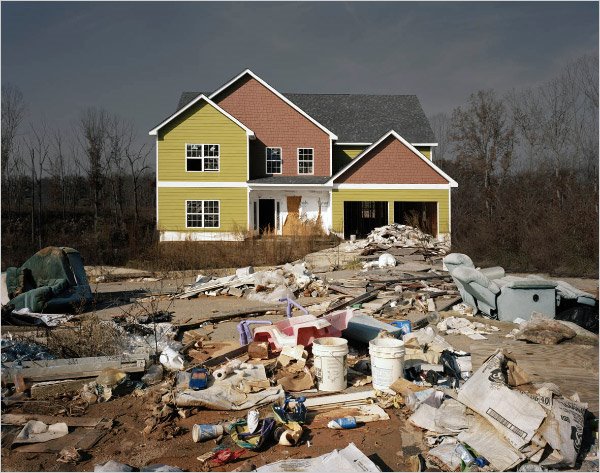
Photo: Edgar Martins for The New York Times
I recently came across a New York Times Magazine picture essay by photographer Edgar Martins published in the Time's Architecture Issue called "Ruins of the Second Gilded Age." I have always been interested in the built environment, especially in relation to suburbia. For too long now America has over-relied on designing cities for cars and not people. This design practice has led to an unsustainable housing dream.
The New York Times story featured quiet pictures of abandoned construction sites. Overzealous devolopers had left these building projects in this economic downturn and turned them into ghost houses. When the 5th image loaded (see above) I was struck by the aesthetic similarity to my own project, affordable homes (see below image).

©2004 harlan erskine, '#14967 B 26/58', c-print, 20 x 25 inches from the triptych affordable homes
My image was taken as the real estate market was heating up in Miami. Developers were building huge clusters of McHomes closer and closer to the everglades and in areas that used to be farmland. The homes have been finished by now. At least one resident has occupied them since their completion. I made the images out of frustration with the banality and cheapness of their design, construction and planning. How can we look at these creations as Americans and not ask: is the future we want? Building homes in this manner is unsustainable--a fact that we are only beginning to digest as a nation. The results of these careless choices will reverberate through our economy for generations.
The images by Edgar Martins warranted a blog posting. I pasted the links into Blogger with a quick outline and saved it for a later posting. I experienced all these images on the small screen and have yet to see the printed version. If that was the end of this story, this post would end here. Tonight as I revisited the links, I loaded the Time's webpage and found a note from their editors.
Editors' Note: July 8, 2009
A picture essay in The Times Magazine on Sunday and an expanded slide show on NYTimes.com entitled "Ruins of the Second Gilded Age" showed large housing construction projects across the United States that came to a halt, often half-finished, when the housing market collapsed. The introduction said that the photographer, a freelancer based in Bedford, England, "creates his images with long exposures but without digital manipulation."
A reader, however, discovered on close examination that one of the pictures was digitally altered, apparently for aesthetic reasons. Editors later confronted the photographer and determined that most of the images did not wholly reflect the reality they purported to show. Had the editors known that the photographs had been digitally manipulated, they would not have published the picture essay, which has been removed from NYTimes.com.
The photography blogosphere has eaten this story up. PDN Pulse has a long post will several updates running down when the issue was discovered and outlining the offending retouching in a print version of the story. Other photography / art bloggers a photo editor, Gallery Hopper, the online photographer, art most fierce, Joerg Colberg and industry pub Editor and Publisher all have good coverage mixed with their thoughts about this controversy. And now the big bloggers have weighed in with posts from Talking Points Memo, a political blog, Gawker and even the New York Times photography blog, Lens writing about the story from the inside out. (damage control?).

from the PDN Pulse.
With countless more blogs weighing in I figured I would give my two cents.
First, I could care less that an aesthetically manipulated image is illustrating a magazine article. As long as the image is truthful, the alterations don't detract from the article. The photographer has been quoted in many of the above posts as saying, "When I photograph, I don't do any post production to the images, either in the darkroom or digitally, because it erodes the process. So I respect the essence of these spaces."
Why mention it at all? I don't see Gursky or Burtynsky making a big deal about their retouching. Why should anyone? Unless the artist made inept use of Photoshop, there is no problem. Sure, it's not as bad as Iran's retouching missiles or the offenders in this Gawker post, but who really cares? This type of retouching wouldn't fly with any creative director in the advertising business. The art world would laugh at it.
The sad thing is this story is now lost. Before this controversy was discovered by a few Metafilter watchdogs, people were discussing the content of the article. Has this "Second Gilded Age" ended? These discussions were getting some coverage with sites like Tree Hugger and the Times' dot earth. I find it sad that something like this happens and immediately hundreds of commentators flood the blogosphere. Why weren't we discussing it on this level before? What's a more important issue--the economy and the environment or bad retouching by an artist wearing a journalist's hat?
To bring it back to those thoughts, I will point you to a quote posted in the tree hugger blog:
Andy Revkin, who asks:
Are these portraits, perhaps, of the end of the age of unfettered consumption, simply a short pause before human communities resume their 150-years-and-counting fossil-fueled sprint, or a foretaste of Alan Weisman's 2007 thought experiment, "The World Without Us"?
If you want to see the images, the Times still has them up on their site without captions. Just go to this url and change the ending number to access each image.
http://graphics8.nytimes.com/images/2009/06/30/magazine/05gilded.1.jpg





